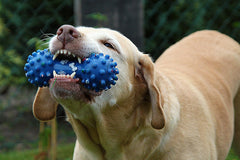
Petting a dog can be very therapeutic for both you and your dog if done correctly. Part of caring for your dog is making sure that you're giving them proper petting.
You may actually be surprised to find out that there is a right and wrong way to pet your dog. These differences come from the location/environment that you pet them as well as yours/their mood at the time.
Petting a dog might not sound like such a complicated feat, but there are definitely some points that should be taken into consideration when interacting with your dog as well as anyone else’s dog. Different kinds of dogs will react differently to being petted. Dog health and dog temperament also are factors that should be considered for these kinds of interactions.
For instance, if a dog is ill they cannot verbally tell you that they are feeling bad but instead might try and nip at someone trying to pet them. This is one of the reasons why taking the time to greet a dog properly and let them initiate contact, is an important step that you will learn more about below.
How to Greet the Dog Before Petting

Greeting a dog is a more important step in petting them than some people may think. This is an especially important step when you are preparing to pet an unfamiliar dog. With your own personal dog, that’s a different story. You two have built a trusting relationship and know that your intentions are not threatening or malicious.
First thing to keep in mind when greeting an unfamiliar dog is to not make direct eye contact. Eye contact with humans is something that all dogs actually hate, but not many people are aware of this. Dogs take eye contact as an aggressive gesture, and it might cause an unfamiliar dog to become defensive or aggressive.
When approaching an unfamiliar dog with the intention to pet them and show them affection you will want to have your eyes averted from them slightly, as to not be making direct eye contact. You’ll also want to have your body slightly angled away from them. Once you’ve managed to approach the dog, you then want to allow them to greet you. You’ll want to squat down and get down on their level and assess whether they feel comfortable with greeting you first.
You can do this by extending your hand and seeing if they feel comfortable approaching you to sniff your hand. You’ll be able to easily tell if they are interested in interacting further with you. They may stay close and even nudge you with their nose if they would like you to pet them. Otherwise, they may take a defensive stance. Which is why you should always keep your fingers folded in towards you, in case they try to snap at them.
What Spots to Pet

With an unfamiliar dog, you will want to avoid petting their head or face, or touching their snout first thing. This is for your own protection, in case they become defensive and try to nip at your hand or arm. Even many family pets who have been around their humans for years don’t prefer to have their head or face touched.
Instead, you should start by petting their shoulders or back. Even the base of their neck is a safe place to pet an unfamiliar dog. If a dog rolls over to show you their belly, it's safe to say that they trust you and would like for you to rub their belly. However, with unfamiliar dogs, you will want to use caution when considering petting their belly.
Remember not to reach over a dog to pet them, especially when you are unfamiliar with them. You wouldn’t want them to feel threatened by this movement and potentially snap at your arm. Reaching over a dog puts you in an extremely vulnerable position to be bitten.
Appropriate Way to Pet

Rule number one when petting a dog, always pet in the direction that their fur goes. If you go against the grain when petting them, you could cause them some discomfort and subsequent stress.
Just like when you are performing dog care and brushing your dog, you would never want to brush against the way that their fur grows naturally. Only become rough and playful with your petting if you know the dog and how they would react to that sort of interaction.
Conclusion
Petting a dog should be a therapeutic experience for both you and the dog. After all, there are so many mental health benefits of petting a dog. It’s important to understand how to approach and become friendly with an unfamiliar dog. Not many individuals know not to make eye contact with a dog when preparing to greet them. Once it’s been established that the dog is ready and comfortable with you petting them, you can then proceed to pet them and begin building a therapeutic relationship with them.
Where to pet a dog?
How to take care of a dog?
Where do dogs like to be pet?
Check out our blog and follow me on LinkedIn to stay up-to-date!




